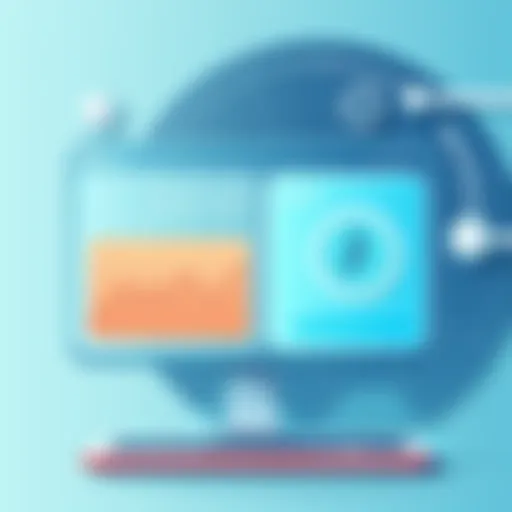Best Rendering Software for Mac: A Comprehensive Guide


Intro
In the modern digital landscape, rendering software serves as a cornerstone for various creative sectors, including architecture, animation, and product design. For Mac users, selecting the right rendering software can be crucial to efficiency and output quality. This article examines several leading rendering solutions available for Mac. By analyzing their features, performance, and feedback from users, it aims to equip decision-makers with the necessary insights to choose the most effective tools for their specific needs.
Software Category Overview
Purpose and Importance
Rendering software is essential for transforming 3D models into realistic images and animations. It enhances visualizations, making them more accessible and relatable. Professionals utilize rendering programs to create compelling graphics that meet both aesthetic and functional standards. From architects visualizing a new building design to animators crafting detailed characters, the importance of high-quality rendering cannot be overstated.
The choice of rendering software also influences workflow efficiency. As workflows vary among different industries, tools need to cater to specific requirements. Thus, an understanding of the software’s purpose can help professionals make informed decisions.
Current Trends in the Software Category
As technology advances, rendering software is continually evolving. Trends such as real-time rendering, cloud-based solutions, and integration of artificial intelligence are shaping the landscape. Real-time rendering provides immediate feedback, enhancing collaboration and decision-making in projects.
Additionally, cloud rendering has gained traction, allowing users to leverage high-performance computing power without requiring extensive hardware setup. Furthermore, AI-driven features help automate various aspects of the rendering process, providing time-saving advantages.
Data-Driven Analysis
Metrics and Criteria for Evaluation
When evaluating rendering software, several metrics are essential for consideration, including:
- Rendering Speed: The time required for a software program to render a scene significantly affects productivity.
- Output Quality: The visual output should meet industry standards in terms of detail and realism.
- Usability: The interface should be user-friendly, allowing professionals to navigate the software with ease.
- Compatibility: The software must operate smoothly with other tools and systems in the user's workflow.
These criteria ensure that users find software that is efficient and suitable for their unique needs.
Comparative Data on Leading Software Solutions
A comparative analysis of the top rendering software for Mac reveals distinct strengths in different programs. For instance, Blender is renowned for its versatility and robust feature set, making it suitable for various use cases. Meanwhile, KeyShot excels in producing high-quality images quickly, appealing to product designers who prioritize speed.
On the other hand, Cinema 4D offers a balance of performance and usability, which can be particularly beneficial for motion graphics and animation projects. Data indicates that many users find it easy to learn while still being powerful enough to handle complex tasks.
"Choosing the right rendering software can make or break a project. It’s essential to align the tool’s capabilities with your specific requirements."
By assessing these software solutions side by side, professionals can identify which options best meet their demands, allowing for informed decision-making.
Prolusion to Rendering Software for Mac
In the realm of digital content creation, rendering software serves as a cornerstone for both artistic expression and technical execution. With the unique capabilities of Mac systems, understanding how to choose rendering software becomes paramount for maximizing productivity and achieving high-quality outputs. This section dives into the intricacies of rendering software specifically tailored for Mac users.
Overview of Rendering Software
Rendering software is a specialized tool that converts 3D models and animations into 2D images or videos. This process is vital in fields such as architecture, animation, and visual effects. Mac does not just offer a sleek interface; it also provides robust performance capabilities, especially in media applications. Most rendering software takes advantage of Mac’s powerful hardware, including its optimized graphics and processing capabilities. This integration allows for efficient workflows, which can lead to faster turnaround times and improved project outcomes.
Rendering software often includes features like shading, lighting, and texturing, which are essential for bringing virtual objects to life. The advancements in rendering technology, especially for Mac, allow users to render in real-time or utilize ray tracing for enhanced visual fidelity. Familiarity with these features is crucial for professionals looking to leverage the full power of their Mac systems.
Importance of Choosing the Right Software
Choosing appropriate rendering software is not just about selecting a popular brand or the one with the most flashy features. It involves evaluating several factors that directly affect a project’s success. The correct software can drastically impact the efficiency of rendering tasks, dictate the quality of visual output, and determine the overall user experience.
First, the compatibility of the software with different macOS versions and hardware specifications is essential. Using software that aligns with a Mac's capabilities means avoiding unnecessary bottlenecks. Also, assessing the user interface and experience can save time during the learning curve and enhance workflow.
Furthermore, it is critical to consider the software’s performance and speed, which are essential for meeting project deadlines. Users should seek software that balances quality rendering with fast processing. Lastly, cost and licensing options present another layer of consideration. Opting for software that offers a sustainable pricing model can lead to a more productive long-term relationship.
"Selecting the right rendering software is crucial for unlocking the full potential of your Mac system, enhancing both creativity and efficiency."
In sum, the right rendering software ensures that users can effectively turn their creative visions into tangible outputs. This article will delve deeper into various software options available for Mac users, evaluating their features and suitability for different creative processes.
Criteria for Evaluating Rendering Software
When selecting rendering software for Mac, several criteria are crucial to consider. Each aspect contributes significantly to the overall experience and efficiency of the user. A thorough understanding of these criteria can guide users toward the best software choices tailored to their specific needs and professional requirements.
Performance and Speed
Performance is perhaps the most vital aspect when evaluating rendering software. Rendering can be an intensive process. Therefore, efficient CPU and GPU utilization is essential. Fast rendering speeds save time, which translates into increased productivity.
Several software options have distinct advantages in terms of speed. For example, Blender is known for its optimization features, making it suitable for various projects, from simple animations to complex 3D scenes. Additionally, with advances in technology, consider how well the software can leverage the latest hardware trends. Users should assess performance benchmarks reported by peers or in reviews to gain insight into real-world operation.
User Interface and Experience
The user interface (UI) can greatly influence the user experience. An intuitive UI enables easier navigation through complex tools. This reduces the learning curve and helps professionals focus on creativity rather than functionality.
It's vital to consider how user-friendly the software is, particularly for those new to rendering. Programs like Cinema 4D have gained a reputation for their clean and organized UI, which appeals to both novices and experts. In contrast, software with a cluttered or overly complicated interface can lead to frustration, impacting the overall workflow negatively.
Compatibility with Other Tools
Another critical factor is the software's compatibility with other tools and software. Many professionals rely on a suite of applications for their projects. Thus, seamless integration helps maintain the flow of work. For example, Autodesk Maya is frequently noted for its ability to work alongside tools like Adobe After Effects and other media production software, enhancing the creative process.


Evaluating this attribute means checking essential file types and formats supported by the rendering software. Ensure that the tools you plan to use alongside the rendering software can efficiently communicate with it.
Cost and Licensing Options
Lastly, it is necessary to consider the cost and licensing structure of the rendering software. Some tools, like Final Cut Pro, require significant upfront investment but offer extensive features. Others, such as Blender, are open-source and free to use, providing a budget-friendly option for smaller studios or individuals.
Understanding the licensing terms is essential. Some software may operate on a subscription model, while others are available for one-time purchase. Consider your long-term goals and whether the software meets your budget while still providing adequate features for your needs.
Investing in the correct rendering software can greatly affect productivity and project quality.
Evaluating performance, user experience, compatibility, and cost provides a comprehensive approach to selecting the right rendering software for Mac. By focusing on these critical areas, professionals can make informed decisions that align with their project's requirements and personal preferences.
Top Rendering Software Options for Mac
The landscape of rendering software for Mac is diverse and includes various applications suited for different workflows and industries. Understanding the top software options available can enable users to select the ideal tools that match their specific needs. This section will highlight several key choices and provide insights into their features, performance, and user experiences.
Blender
Overview of Features
Blender is a standout choice among rendering software due to its extensive and robust feature set. It offers modeling, animation, rendering, and compositing tools all in one package. The versatility of Blender allows users to work on projects ranging from simple to highly complex, making it a popular option in the creator community. The software is also open-source, which means it receives continuous updates and improvements from a large base of contributors.
One of the most beneficial aspects of Blender is its support for both 2D and 3D projects, making it an excellent choice for various creative workflows. However, the software's complexity can be daunting for new users, requiring a bit of a learning curve.
User Community and Resources
The user community surrounding Blender is large and active. Numerous forums, tutorials, and documentation are available for users seeking assistance or resources. This strong community support ensures that users can find help as they learn the software or troubleshoot issues.
Additionally, the official Blender website and resources like YouTube are great places to find video tutorials. While the plethora of information can be overwhelming, it often enhances the user's ability to master the software effectively.
Cost Analysis
Cost is always an essential factor when evaluating software, and Blender excels in this area. Being free and open-source, it allows users to access high-quality rendering tools without the financial burden associated with many other options. This accessibility makes it attractive to students or freelancers who may not have substantial budgets.
However, while free, users may encounter limitations in professional settings, particularly regarding ongoing support and advanced features found in paid software.
Cinema 4D
Rendering Capabilities
Cinema 4D is renowned for its exceptional rendering capabilities. It includes advanced global illumination and physically-based rendering options, which create realistic results with less effort. This ease of use is a primary reason many professionals prefer this software.
The unique feature of Cinema 4D is its ability to handle complex scenes without significant slowdowns, allowing for a more efficient workflow. This quality makes it a favorite among motion graphics artists. However, its advanced capabilities may also lead to a steeper learning curve for newcomers.
Integration with Other Software
Integration capabilities are crucial in today’s mixed software environments. Cinema 4D provides highly seamless integrations with applications like Adobe After Effects and Photoshop, allowing for streamlined project management across various platforms.
This compatibility not only saves time but enhances overall productivity. However, users may require additional steps to configure these integrations satisfactorily.
Training Resources Available
Training resources for Cinema 4D are plentiful. From online courses to comprehensive tutorials, users can find quality instruction to enhance their skills. Many third-party platforms also offer specialized training tailored to specific needs.
However, while the abundance of resources can be helpful, staying updated with the latest software features can be challenging due to continual updates.
Autodesk Maya
Features Relevant to Mac Users
Autodesk Maya is another powerful option, especially for users focused on animation and visualization. It offers an extensive toolset tailored for 3D modeling, which is optimal for sculpting and rigging assets. Native support on macOS allows users to benefit from a smooth experience while utilizing its robust features.
A unique aspect for Mac users is Maya’s integration with Apple’s graphics capabilities, such as Metal, which ensures enhanced performance and rendering quality. However, the complexity of Maya can be a barrier for less experienced users.
Performance Benchmarks
When analyzing performance benchmarks, Autodesk Maya consistently ranks favorably among its peers. Its rendering engine provides high-quality output and intuitive controls, allowing for swift adjustments. Benchmarks indicate that projects load quickly and run smoothly, which is crucial for demanding workflows.
Despite these strengths, performance can be highly dependent on the user's hardware specifications. Thus, ensuring adequate system resources is vital for optimal experience.
Pricing Structure
Autodesk Maya employs a subscription pricing model, which may be a consideration for potential users. While it offers a robust feature set, the monthly or annual fees can quickly add up, making it less accessible for casual users.
However, for professionals, the investment is often justified by the high quality and feature depth that Maya offers.
Final Cut Pro
Focus on Video Rendering


Final Cut Pro is tailored for Mac users who prioritize video rendering. Its intuitive timeline and advanced rendering techniques allow for high-quality video projects. The software supports multicam video editing, making it ideal for professionals working on complex video productions.
The ability to render proxies and work seamlessly with 4K footage adds significant value. However, the software might not be the best fit for 3D rendering tasks, as its features are heavily focused on video editing.
Unique Features for Mac Users
Final Cut Pro leverages macOS's capabilities uniquely. The software is optimized for Apple’s hardware, ensuring it runs efficiently with fewer bugs. Benefits like background rendering and the magnetic timeline streamline workflows significantly.
However, users transitioning from other video editing software may need time to adjust to its unique features.
User Feedback and Case Studies
User feedback for Final Cut Pro tends to be overwhelmingly positive, particularly in the realm of pro video editing. Professionals in the industry often cite its robust features as essential for high-quality production. Case studies show significant time savings during projects, thanks to the software's efficiency.
Despite this, new users may find some advanced features to be challenging initially.
Lightwave 3D
Strengths and Weaknesses
Lightwave 3D has long been a reliable choice among rendering software, known for its strong capabilities in both modeling and rendering. The software is particularly favored for visual effects due to its flexibility and adaptability.
While its user interface might feel dated compared to contemporaries, many users find its core functionality robust. However, the lack of recent updates raises concerns regarding its future viability.
Learning Curve and Support
The learning curve for Lightwave 3D can be steep. New users may struggle to become accustomed to its workflows compared to more modern software options. However, the community around Lightwave is supportive, providing forums and resources that assist new users as they navigate their challenges.
Nevertheless, the support may not be as abundant as seen with more popular software packages, which could hinder progress for some.
Cost-Benefit Analysis
Lightwave 3D has a competitive pricing structure, often requiring lower upfront costs than some other professional options. This aspect can be appealing for freelancers or smaller companies.
Yet, potential users should critically assess the software's return on investment, particularly against newer competitors that may offer more features for similar pricing.
Emerging Software in Rendering
Emerging software in rendering is a critical topic in the context of this guide. As the industry evolves, newer tools and technologies continuously redefine rendering capabilities. These emerging software solutions not only introduce innovative features but also cater to specific needs of users across various sectors. Understanding these trends is crucial for professionals who wish to stay ahead in their field. Emerging tools can offer enhanced efficiency, superior quality, and often more cost-effective alternatives compared to established software.
New Entries in the Market
In the past few years, several new rendering software packages have entered the market, each aiming to address gaps left by existing solutions. Tools like Octane X and RenderMan have gained traction among users seeking advanced rendering features optimized for Mac.
- Octane X is known for its real-time ray tracing support, which significantly speeds up the rendering process. This tool allows for visual effects and animations that were previously complex to achieve within a shorter time frame, making it appealing for artists looking for productivity boosts.
- RenderMan, developed by Pixar, continues to push boundaries. Its recent updates focus on enhancing support for artistic styles and improving integration with popular 3D modeling software. This adaptability is particularly attractive for animation studios and visual effects artists.
The arrival of these tools has led to increased competition, encouraging further enhancements in functionality and ease of use among all rendering software.
Innovative Features to Watch
As more rendering software emerges, certain innovative features stand out and promise to change the workflow for users:
- Real-time Rendering: This feature allows users to see their changes instantly, transforming the way artists approach their projects. Instant feedback can enhance creativity and speed up the decision-making process.
- Cloud Rendering Options: More software is integrating cloud capabilities. This feature not only increases rendering power but also allows teams to collaborate more effectively, regardless of geographical barriers.
- AI-assisted Rendering: AI technology is making waves in the rendering space, with tools that suggest optimal settings and parameters based on project requirements. This can greatly reduce the learning curve for newcomers and speed up production.
"As technology advances, the integration of AI in rendering software will provide users with capabilities that were unthinkable just a few years ago."
These innovative features represent an important shift in how rendering is experienced by professionals. Choosing the right software that incorporates such advancements can lead to more effective workflows, elevating the quality of the end result.
Industry-Specific Recommendations
Rendering software selection requires careful consideration based on the particular needs of various industries. Each field has unique demands and expectations for rendering quality, speed, and software capabilities. Understanding these specific requirements is essential for professionals aiming to enhance productivity and achieve superior results in their projects.
Industry-specific recommendations serve to inform users about the most suitable software options tailored to their particular domain. Such guidance enables architects, animators, and video producers to maximize their efficiency with tools that are optimized for their workflows. By focusing on craft-specific software, users can avoid the pitfalls of choosing a generic solution that may not accommodate their specific needs or lacks certain features.
Realizing the significance of industry-focused software recommendations helps organizations save time and resources while improving project outcomes. Hence, this section will provide detailed insights into optimal rendering software choices for architecture, animation studios, and video production.
Rendering Solutions for Architecture
In the architecture field, rendering software is vital for creating realistic visual representations of designs. Architects rely on software that not only provides aesthetic accuracy but also integrates well with architectural modeling tools. Programs like SketchUp combined with Lumion are particularly effective as they facilitate quick iterations and real-time rendering, enhancing collaboration in design processes.
Architects need software that supports advanced lighting, textures, and environmental simulation to depict designs accurately. Look for features like:
- Photorealistic rendering capabilities
- Support for visualization tools like VR panoramas
- User-friendly interfaces that simplify the design process
The ability to create life-like representations helps in securing client approvals and elevating project presentations. Thus, software such as Enscape or Twinmotion might be excellent choices for architectural firms looking to enhance their presentations.
Software for Animation Studios
Animation studios demand rendering software that can create high-quality animations with complex scenes efficiently. The key elements for such studios include the balance of power, flexibility, and support for features like rigging, texture painting, and compositing. Software like Autodesk Maya and Cinema 4D are typically popular for animation work due to their rich feature sets and robust user communities.


An essential consideration for these studios is:
- Animation-specific rendering options, including motion blur and depth of field effects
- Compatibility with industry-standard plugins and tools
- The ability to render in various formats optimal for film and gaming applications
The software's capability to manage heavy scenes without sacrificing quality is critical. Animation studios will benefit greatly from using software that provides rapid rendering and seamless integration with other production tools.
Options for Video Production
In video production, the rendering software's efficiency and rendering speed are paramount. Producers need tools that streamline workflows and enhance post-production processes. Software such as Final Cut Pro stands out due to its seamless integration with macOS, advanced color grading tools, and support for high-resolution video formats.
Considerations when selecting a rendering solution for video work include:
- Real-time editing capabilities to speed up the workflow
- Availability of specialized filters and effects tailored for video
- Supports various output formats for different platforms
Choosing the right rendering software can significantly impact the overall productivity of video production teams. Software like Adobe Premiere Pro and DaVinci Resolve offer powerful rendering solutions to find the balance between quality and performance.
The choice of rendering software can either support creative visions or hinder them, making informed decisions crucial for industry success.
Ultimately, aligning rendering software with industry specifics is vital for achieving desired outcomes and efficiently navigating the demands of today's competitive markets.
Integration with Mac Ecosystem
In the realm of rendering software for Mac users, integration with the Mac ecosystem is crucial. It is not merely about installation; it is about how well the software interacts with macOS and its hardware. Efficient integration can lead to enhanced performance and easier workflows. A software that aligns seamlessly with Apple’s operating system often boosts user productivity significantly. Whether it is through native compatibility or leveraging Apple-specific features, the benefit tends to be a smoother experience overall.
Compatibility with macOS Versions
Compatibility with macOS versions is key to ensuring software operates efficiently on a Mac. Apple frequently updates macOS, introducing new features, security enhancements, and user interface changes. Therefore, prospective users should check if their desired rendering software supports the latest macOS version. For instance, tools like Blender and Final Cut Pro are actively maintained, receiving regular updates to ensure functionality across various macOS versions.
Software that lacks compatibility can lead to numerous problems, such as performance hits or even crashes. This is particularly vital for professionals relying on rendering software in demanding environments. As such, evaluating the software's track record for compatibility with both current and past versions of macOS is essential before making a decision.
Utilizing Apple’s Hardware Features
Utilizing Apple’s hardware features can provide significant advantages when using rendering software. Modern Mac computers come equipped with advanced graphics processing units (GPUs) and optimized central processing units (CPUs). Rendering software that taps into these capabilities can dramatically speed up rendering times and overall performance. For instance, software like Cinema 4D has mechanisms in place to utilize Metal, Apple's graphics API, to leverage GPU power effectively.
Beyond just speed, software that makes full use of the hardware often leads to better resource management. Users can expect less sluggish behavior when multiple applications are open.
In summary, compatibility with macOS versions and the ability to utilize Apple’s hardware features are vital considerations when selecting rendering software for Mac. They ensure that users can work efficiently and effectively, maximizing the capabilities of their hardware while minimizing technical issues.
"Choosing software that fits well within the Mac ecosystem is more than a preference—it's a necessity for serious professionals."
Understanding these dimensions can guide users toward making informed choices, enhancing their professional workflows and creative outputs.
User Experiences and Case Studies
User experiences and case studies play a significant role in understanding rendering software for Mac. These aspects illuminate real-world applications, showcasing how professionals utilize various tools to achieve their goals. By analyzing success stories, one can gain insight into the efficiency of specific software, how it handles complex tasks, and its overall effectiveness in diverse environments. Moreover, these experiences highlight user satisfaction and common pitfalls, offering invaluable lessons for potential users.
In an industry where performance and functionality are paramount, user experiences can offer feedback that shapes development. They indicate what features are truly beneficial and which may require improvement. Additionally, understanding case studies provides context for the performance metrics and specifications mentioned in product descriptions. Users can relate more closely to peers who have faced similar challenges, aiding them in making informed decisions that fit their unique needs.
Success Stories
Several success stories exemplify the critical impact of choosing the right rendering software for Mac. For instance, a renowned architecture firm leveraged Autodesk Maya for its intricate design projects. The software's advanced rendering capabilities allowed the team to produce high-quality visualizations, impressing clients and securing new contracts.
Another example is an animation studio using Blender to create an award-winning short film. The studio took advantage of Blender's extensive modeling tools and active community support, which provided resources and tips that enhanced their workflow. As a result, they produced a visually stunning product with minimal budget constraints.
"Real-world implementation of software often highlights strengths that benchmarks cannot fully capture."
These cases illustrate how strategic selection of rendering software directly contributes to professional success. They encompass elements such as productivity boosts, enhanced collaboration, and the ability to tackle complex requirements, reinforcing the importance of thoughtful software evaluation.
Common Challenges Faced
Despite the various advantages, users of rendering software for Mac encounter specific challenges. One common issue reported is the steep learning curve. For instance, professionals transitioning to Cinema 4D often find it daunting due to its extensive features and tools. This initial difficulty can slow down productivity and discourage users from fully utilizing the software's potential.
Another frequent challenge involves compatibility issues. While some users appreciate the integration features of Final Cut Pro, others experience difficulties when trying to import assets from other software. This can disrupt workflows and create frustration during projects.
Budget constraints represent another challenge. Although many powerful rendering solutions exist, their pricing may not be viable for small businesses or freelance designers. The trade-off between functionality and cost is a critical factor that can restrict access to high-quality rendering tools.
By recognizing these challenges through user experiences and case studies, potential users can prepare and strategize effectively. Knowing what obstacles might arise encourages more informed decision-making and can lead to more successful project outcomes.
Finale and Future Outlook
As the world of rendering software continues to evolve, understanding the implications of technology is crucial for professionals seeking the best tools. The conclusion here encompasses more than just a summary; it emphasizes the significance of selecting the right rendering software, particularly for Mac users. Choosing compatible software can directly impact workflow efficiency and the overall quality of output. In rendering, the right software enables artists and developers to leverage hardware capabilities and improve productivity.
Recap of Key Insights
This article has presented a comprehensive overview of rendering software tailored for Mac users. Key insights include:
- Performance and Speed: Analyzing software capabilities to handle demanding projects.
- User Interface: The importance of a user-friendly design impacting usability and efficiency.
- Compatibility: Ensuring software works well with other tools in a professional workflow.
- Cost Considerations: Evaluating pricing against features to make informed financial decisions.
Each software option discussed has its strengths, suited for specific industries, such as animation or architecture. As users navigate these choices, understanding their needs is essential for maximizing output quality and streamlining processes.
Trends to Watch in Rendering Software
The landscape of rendering software is witnessing innovative changes. Key trends to observe include:
- Real-Time Rendering: This feature allows creators to visualize changes instantly, facilitating faster iterations and enhanced collaboration.
- Cloud-Based Solutions: More developers are leveraging the cloud for rendering, providing scalability and accessibility.
- AI Integration: Artificial intelligence is being used to optimize rendering processes, improving efficiency and accuracy.
- Cross-Platform Compatibility: The shift towards tools that operate seamlessly across Mac and Windows encourages broader accessibility.
"Staying informed on these trends allows professionals to adapt and enhance their creative workflows effectively."







